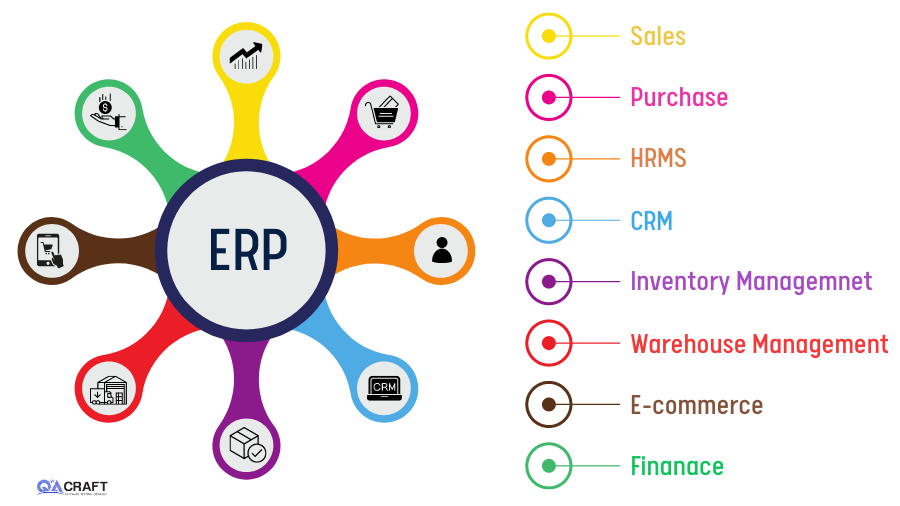11 Mar

What is ERP Testing?
The process of confirming the functionality of your ERP software solution during implementation is referred to as “ERP testing.” ERP testing is a quality assurance (QA) process that ensures the ERP system is properly implemented and operating prior to its full launch.
ERP testing at various phases of the installation process helps to avoid unpleasant surprises like the program crashing during go-live. It also reduces the number of bugs discovered after implementation.
ERP Domain Knowledge for Software Testers

What is ERP?
ERP stands for Enterprise Resources planning. It’s a software system that basically increases the efficiency and productivity of a company’s employees by simplifying workflow and processes. Enterprise Resources planning is software that controls the core functionality of a company (for example. HR, payroll, finance, etc).
It helps to consolidate all these different sub-systems in one place in a way that enables the easy flow of data and information from one system to the other. nowadays most companies are switching to Enterprise Resources Planning Systems to do away with a lot of prosaic and manual data entry work.
ERP Testing Types
Types of ERP Testing are as follows:
1) Functional Testing
Functional testing ensures that each and every module of the system is working as expected once all the company-related customization is done.
2) Performance Testing
Performance testing may be needed to check how the software performs under load. In most organizations, the load on the system would be negligible since people may not log in to the software regularly, but there are some cases like when the hike letters are released or the last day investment declarations, in such case performance testing should be needed.
3) Security Testing
ERP system contains employee-related data, thus it’s very important to secure this data and to ensure that only an authorized person can access the sensitive data that too on a need basis. this will help to minimize the chances of data theft.
4) Regression Testing
Every time a QA team has to run a check-up after the code changes to ensure that the already working functionality is not affected and the system works as expected.
5) Acceptance Testing
This testing is the final check-up of the system before the release, it’s part of stakeholders or any other trusted individuals who can check out the first version of an ERP system that is ready for use.
6) Usability Testing
It is mainly divided into transparency, understandability, operability, attractiveness, and compliance. usability is the ease of use, it defines how a user can easily understand our software, how easily they will use our product, and its attractiveness to the user under specified requirements determined by stakeholders or clients.
This type of testing is usually brought off by real-time users and not by the development team. The development team is only responsible for the development of the product and hence they fail to find fewer defects that are related to user experience.
Different categories of Usability testing are:
- Explorative
- Assessment
- Comparative
7) Smoke Testing
Smoke testing always confirms that the build that we have received supports the basic functionality of the application, so it’s essential to check that the system or software application will perform the basic functionality of an application.
8) Scalability Testing
The software will always need some enhancement where we can add a new feature to the system, sometimes enterprise changes their strategies, they will hire new employee, and add new software solution so in this case, scalability testing helps to make sure that we can extend and add some new feature to the system in the future.
Benefits of ERP Systems
- Reusability
- Reduced testing cost and improved resource optimization
- Enhance business reporting
- Better data and cloud security
- Increased productivity
Below is an example of how we can conduct ERP testing step by step :
- When we are ready for ERP testing first, we have to define goals and objectives, and always decide the success parameters by discussing them with the client or stakeholders.
- Create a test plan, A test plan contains all the information related to the testing process, test case, Requirement traceability matrix, test tool, team and schedules, reporting tool, etc.
- Set up a test environment, the test environment is the platform where we run the ERP system and find the major defect.
- When we find a defect on the ERP system, we report that bug and log it into any bug reporting tool as well as create a test report, also we provide all the necessary information to the development team regarding the defect.
- When the defect is fixed in the application we run beta-testing after the initial version of the software is ready. Data that is gathered from the beta testing will help to understand the user experience, and the application can be optimized for a real user.
Conclusion:
ERP system makes the life of employees in an organization much easier after its implementation. The customization, execution, and testing would need a lot of planning, and it’s important to plan the testing of the Enterprise Resources planning system well within a fixed time with proper resources and budget.
Deepali works as a Software Development Engineer in Test, at QACraft, she is a computer science engineer with a degree of bachelor and has 3+Years of experience in the software industry as a Manual Tester and Automation Test Engineer. In her free time, she loves reading and podcasts.
Related Post
Categories
- Agile Testing
- Alpha Testing
- Android App Testing
- API Testing
- Automation Testing
- Banking Domain Testing
- Beta Testing
- cloud testing
- Corporate Life
- cross browser testing
- Cypress Testing
- desktop testing
- Difference
- Domain Testing
- E-commerce Website Testing
- E-learning App Testing
- End-To-End Testing
- Functional Testing
- Game Testing
- Healthcare Domain Testing
- Integration Testing
- Interview Questions
- ios App Testing
- Jenkins
- JIRA
- Katalon
- Manual Testing
- Mobile App Testing
- Monkey Testing
- Non-Functional testing
- Performance Testing
- Postman
- Regression Testing
- Salesforce Testing
- Sanity Testing
- security testing
- Selenium Testing
- Smoke Testing
- Software Testing
- Static Testing
- Test Case
- Test Environments
- Test Scenario
- Test Script
- TestRigor
- Web Application Testing
© Copyright 2025 QACraft Pvt. Ltd. All rights reserved.
Contact : +91 9157786796






deepali